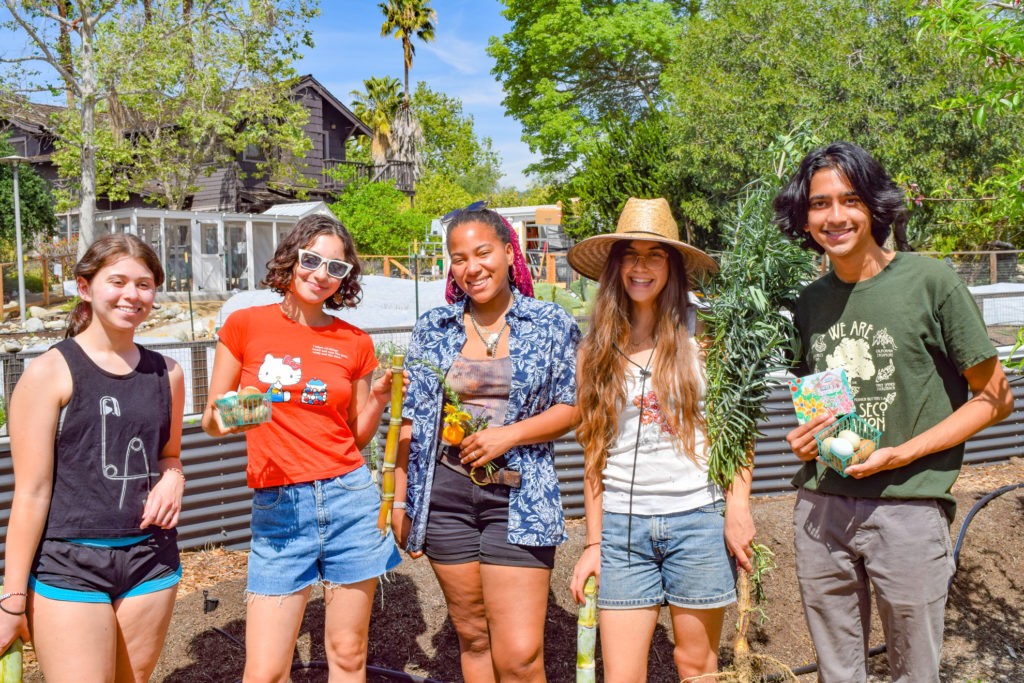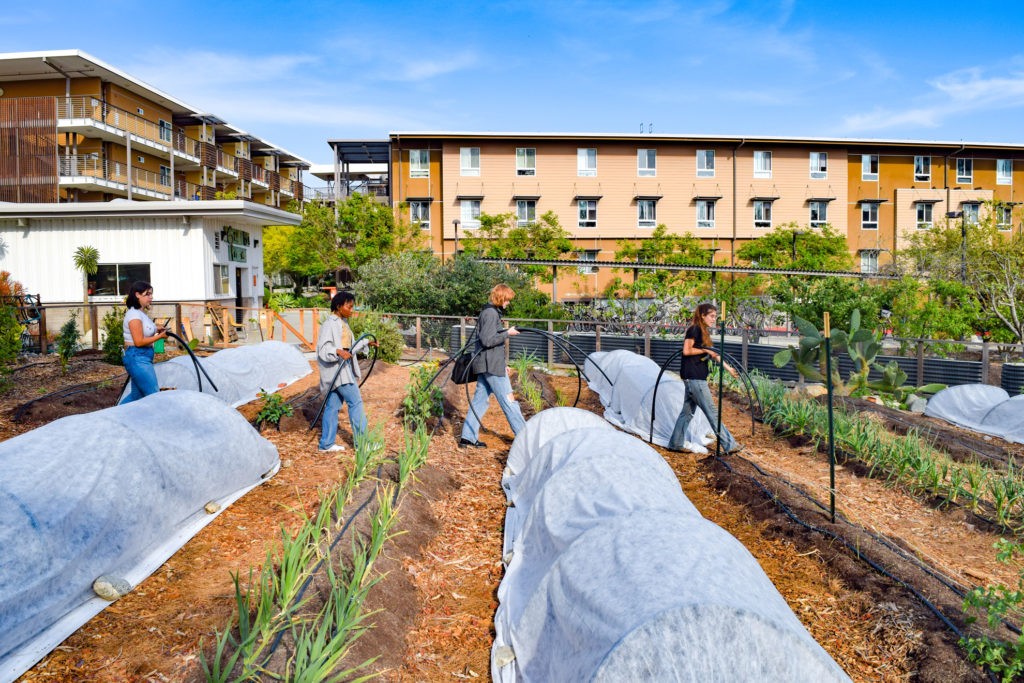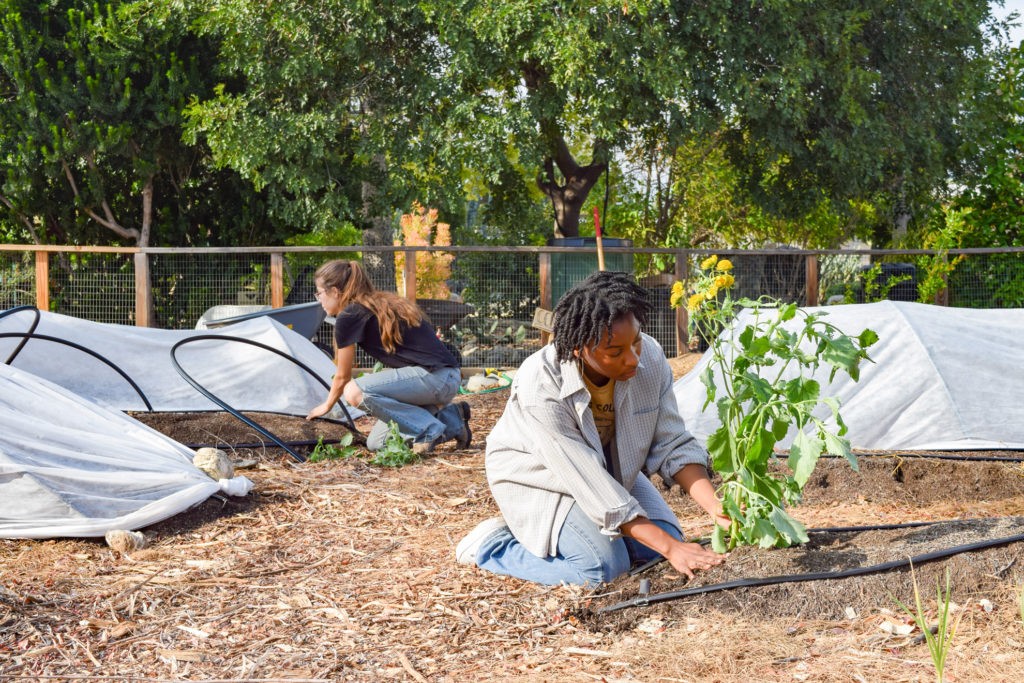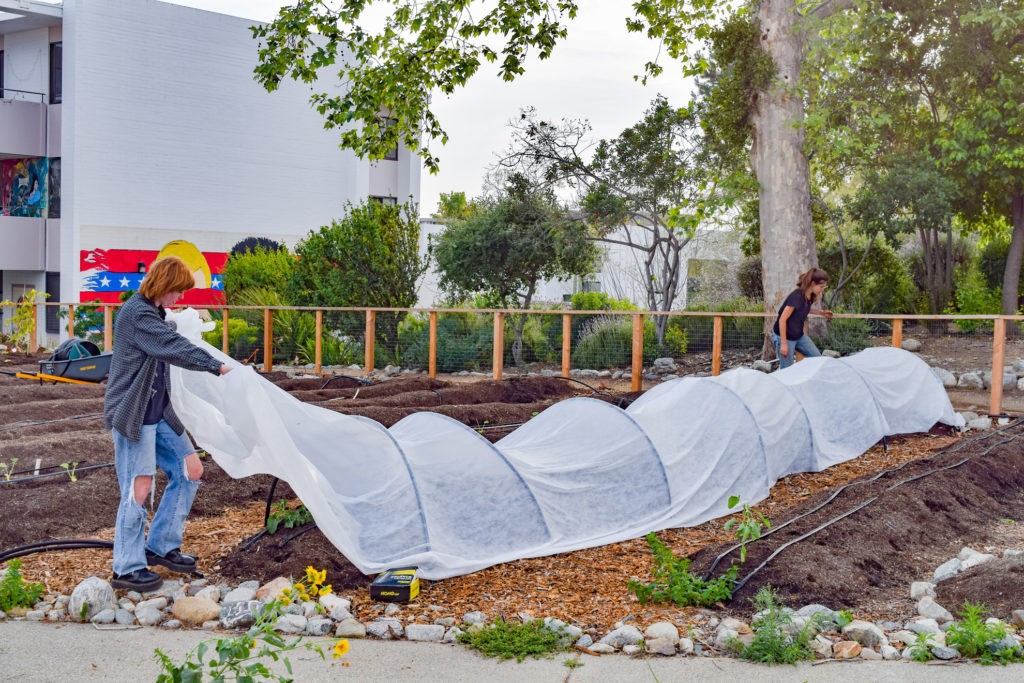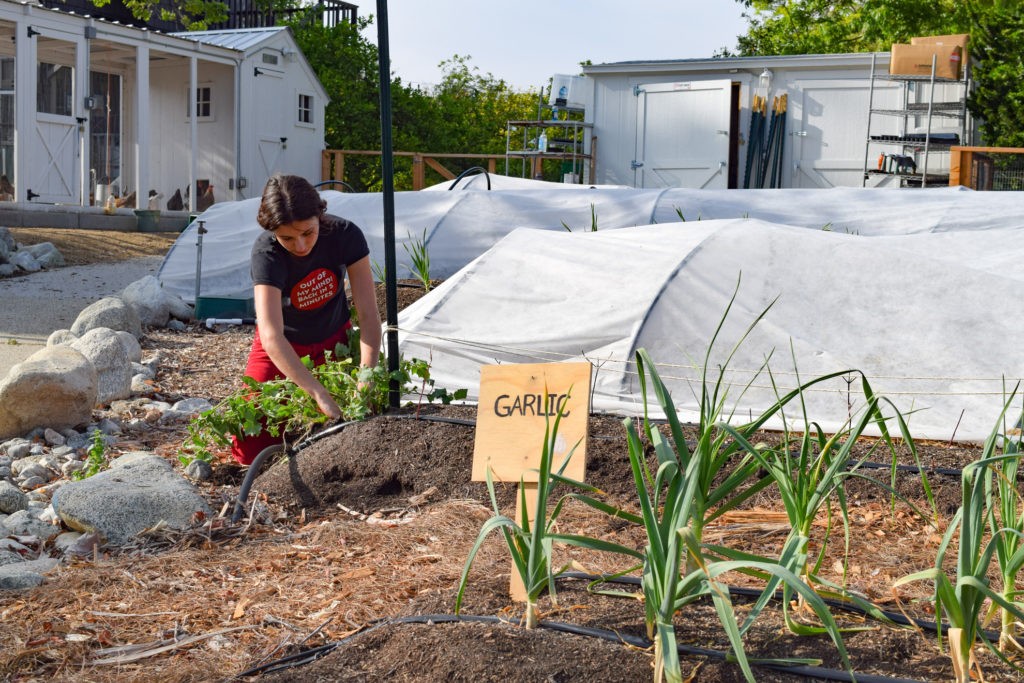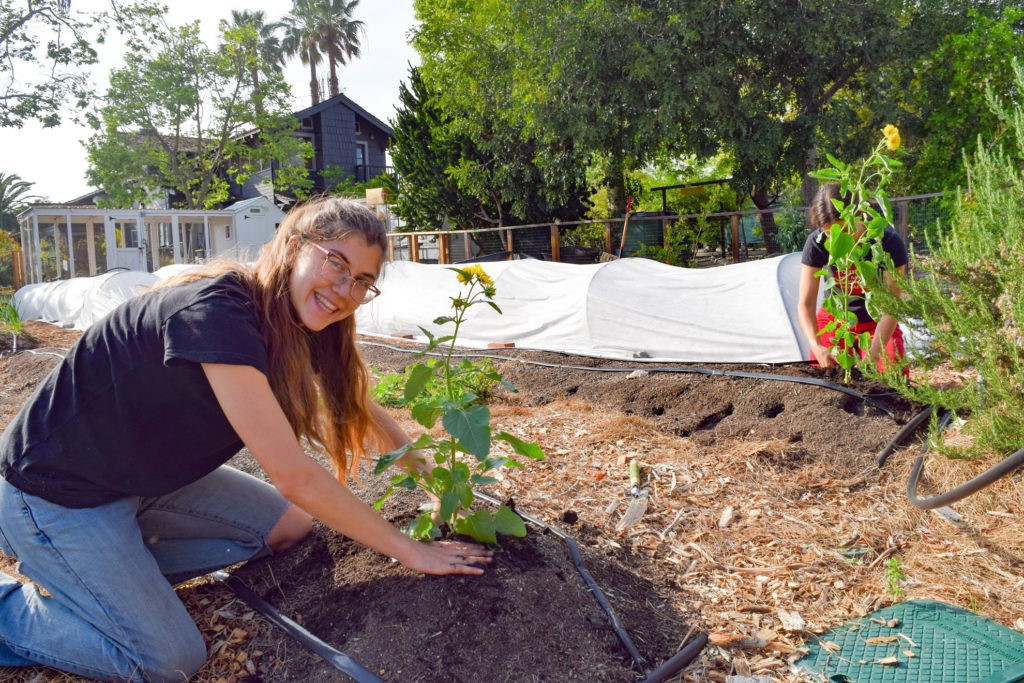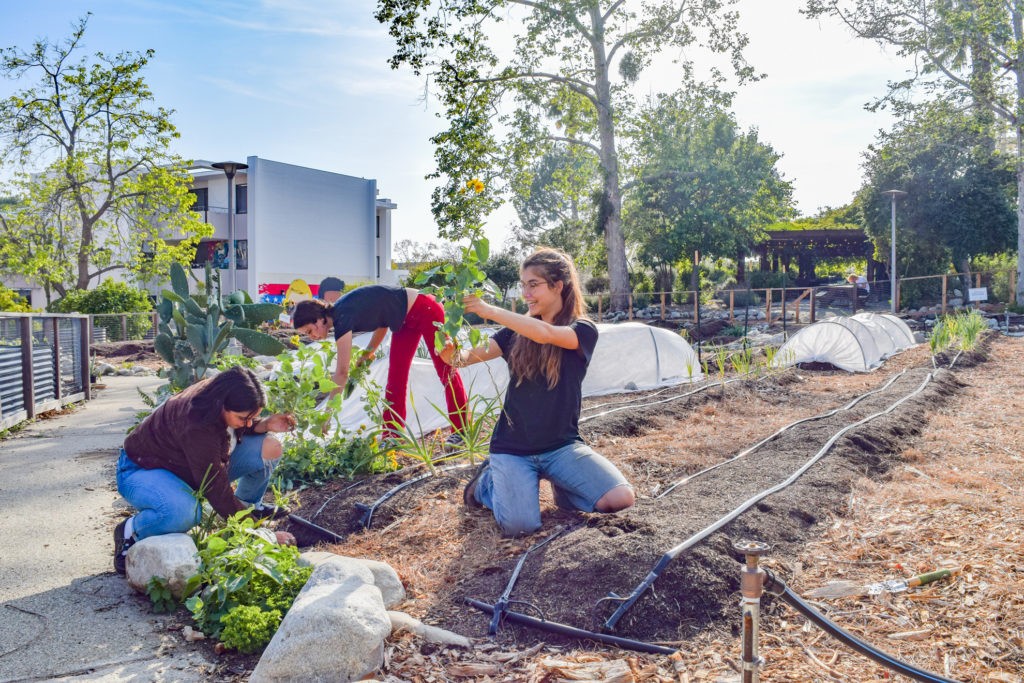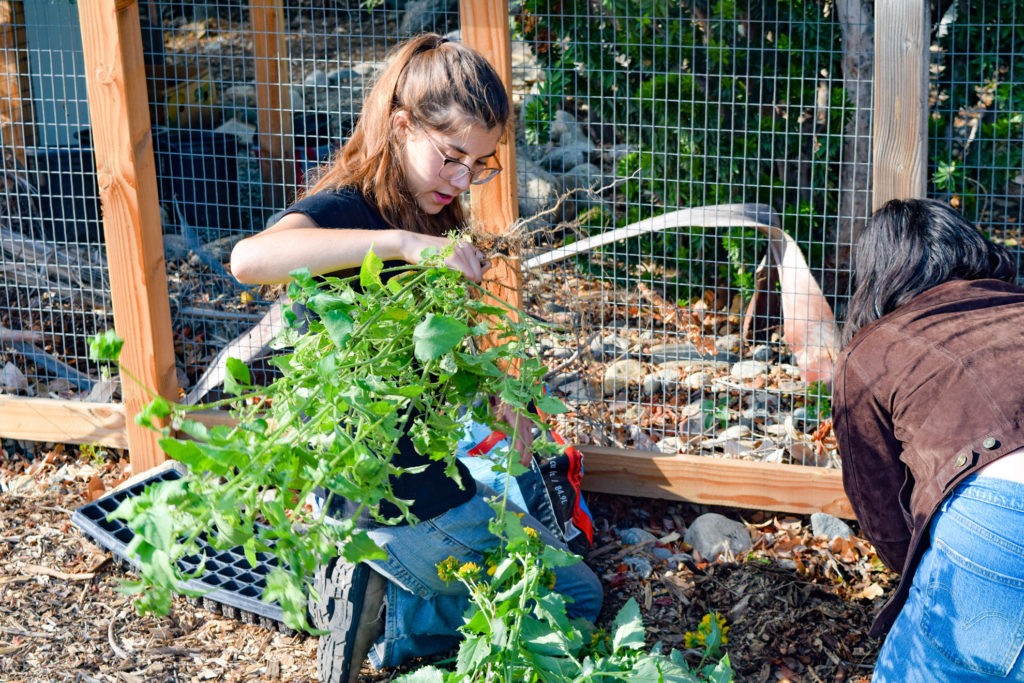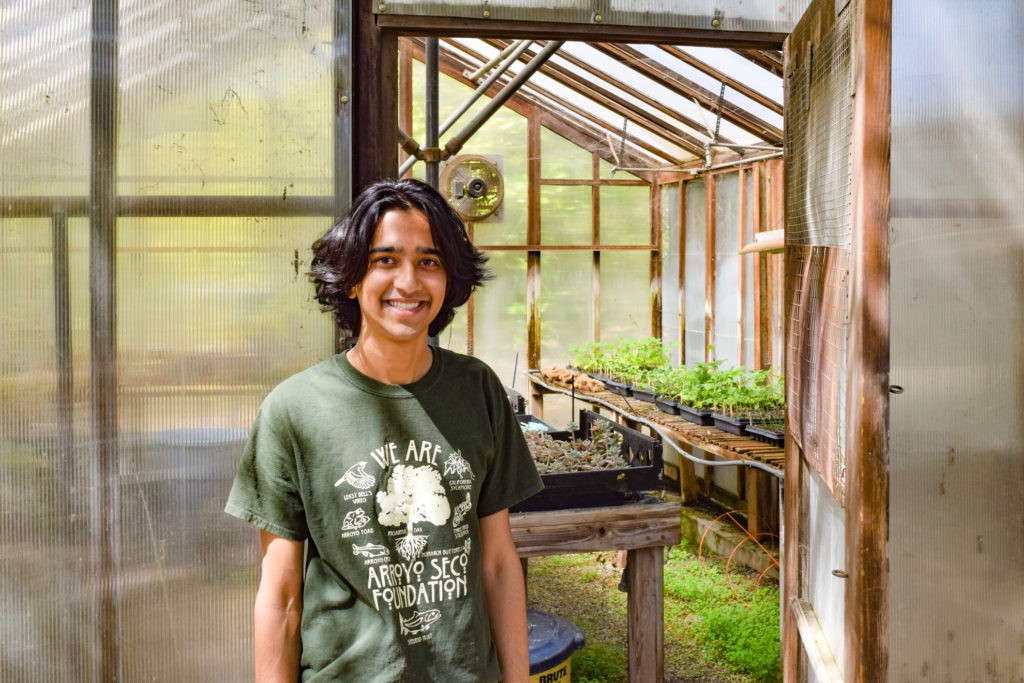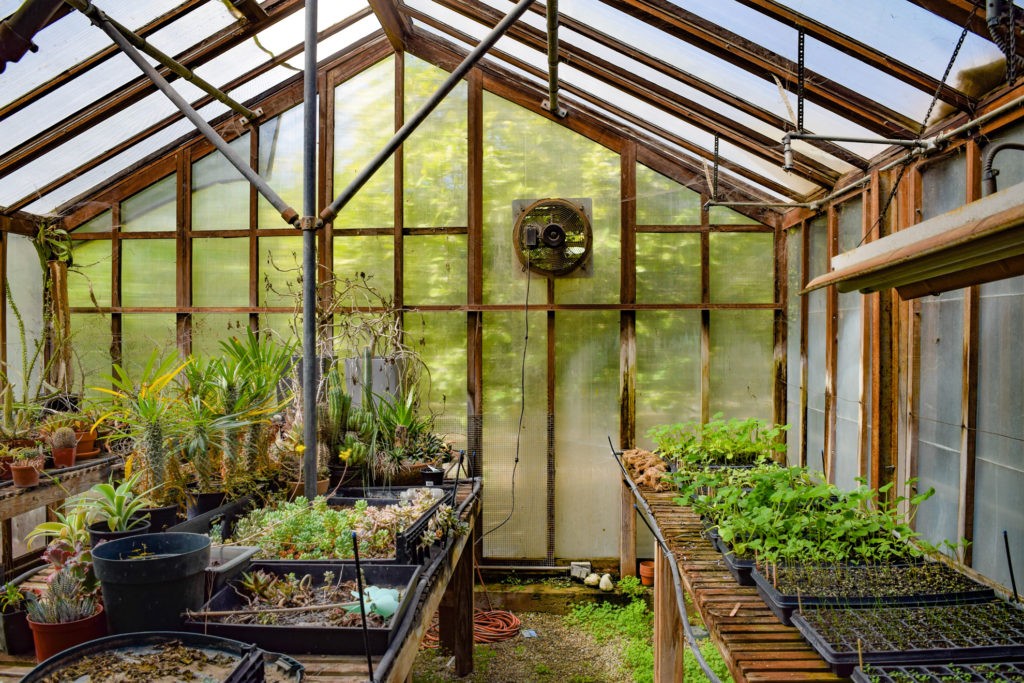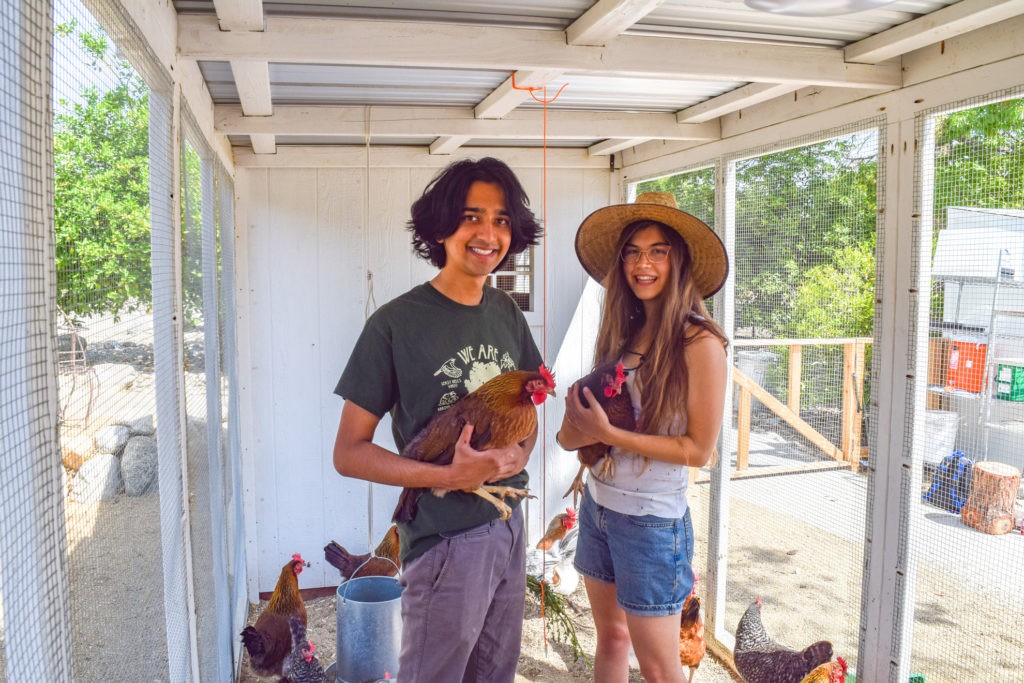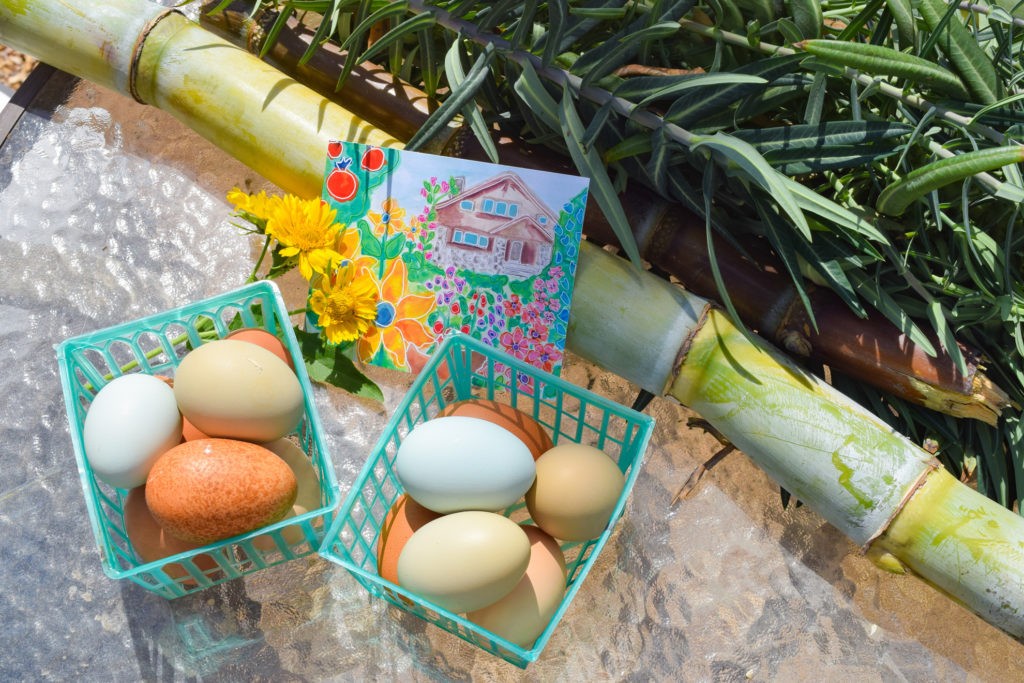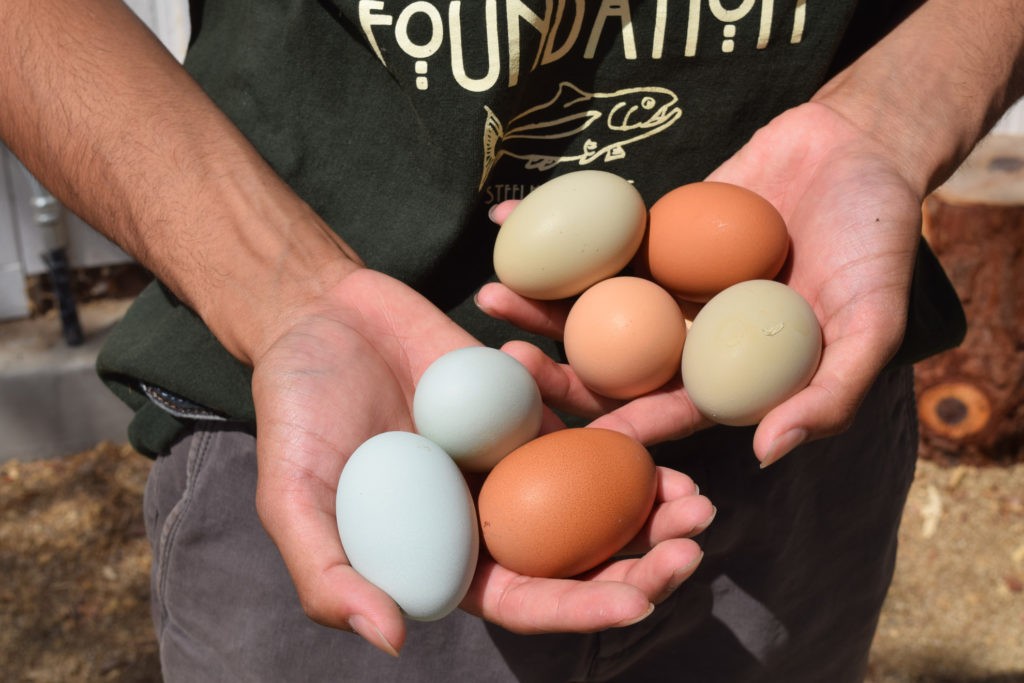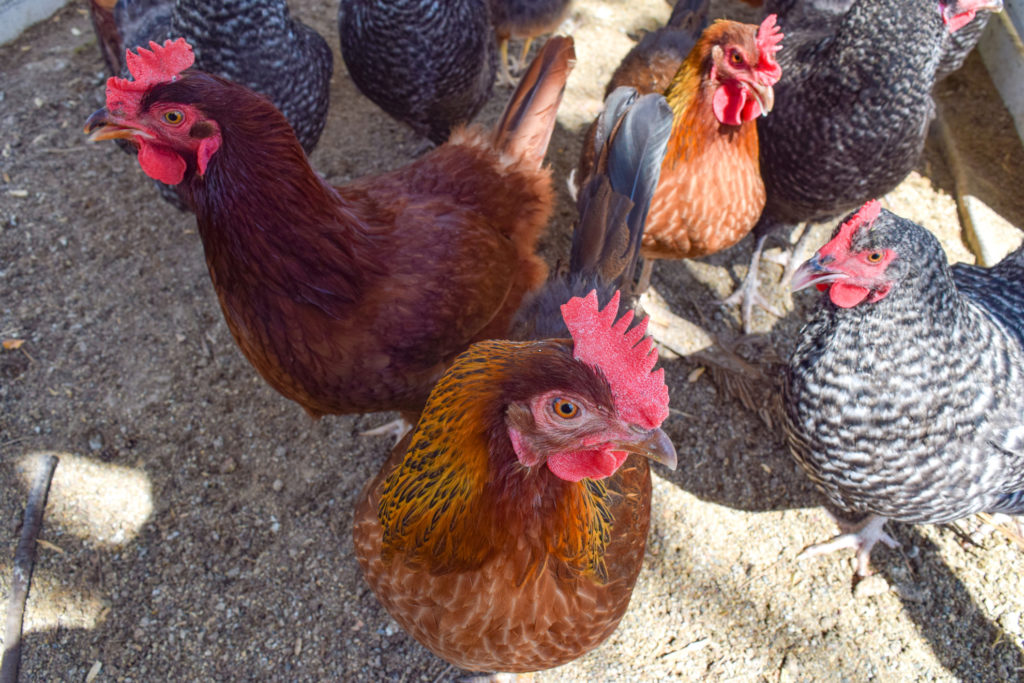Written by Em Kuhn ’22; photos by Kasidit “Gunn” Phikrohkit ’22
Three nearly grown chickens happily nestle themselves into their favorite heaps of fresh soil for a dirt bath as student volunteers squeeze lemons and build raised garden beds around the perimeter of the Pitzer College Student Garden. In the midst of all the activity, a chipper first-year student offers freshly made lemon curd, limeade, and lemony pancakes made from an abundant citrus harvest courtesy of the garden’s orchard.
Since students returned to campus in August 2021, after a year and a half away due to the pandemic, community members have come together to haul over 300 cubic yards of mulch and compost into the previously barren garden plot. We’ve collectively transformed the space by using regenerative agroecology practices like lasagna mulching, companion planting, and mycological remediation to build soil health. Now, as I water the recently planted papaya and pomegranate trees, the garden glows with life. Shoots of new life peek their heads out to drink in the gentle flow of water and the last rays of the setting sun. Fava beans, peas, Swiss chard, onions, garlic, broccoli, carrots … and this is just the beginning!
My last couple of years of college have been spent with my hands in the dirt. Before the pandemic closed Pitzer’s campus in March 2020, I spent the spring semester in Ecuador as part of Pitzer’s study abroad program. When I first visited Yachay Wasi in Quito, Ecuador, the community primary school that would become my volunteer site, I was captivated. Children ran laughing through a terraced forest garden, lush with corn and sunflowers against the mountainous urban backdrop. It was more than the scenery that stuck with me though; it was the history of resistance that is embedded in the school’s pedagogy. The Kichwa chakra, for instance, is an agroforestry garden that holds millennia of cultural heritage. The space serves as a living classroom that maintains a legacy of food sovereignty by nurturing the families of the community and transferring ancestral knowledge to the next generation of stewards. Yachay Wasi is one of the many beacons of hope that demonstrate the dynamic potential of community gardens. My experience there was a pivotal moment for me and continues to guide my work in the student garden.
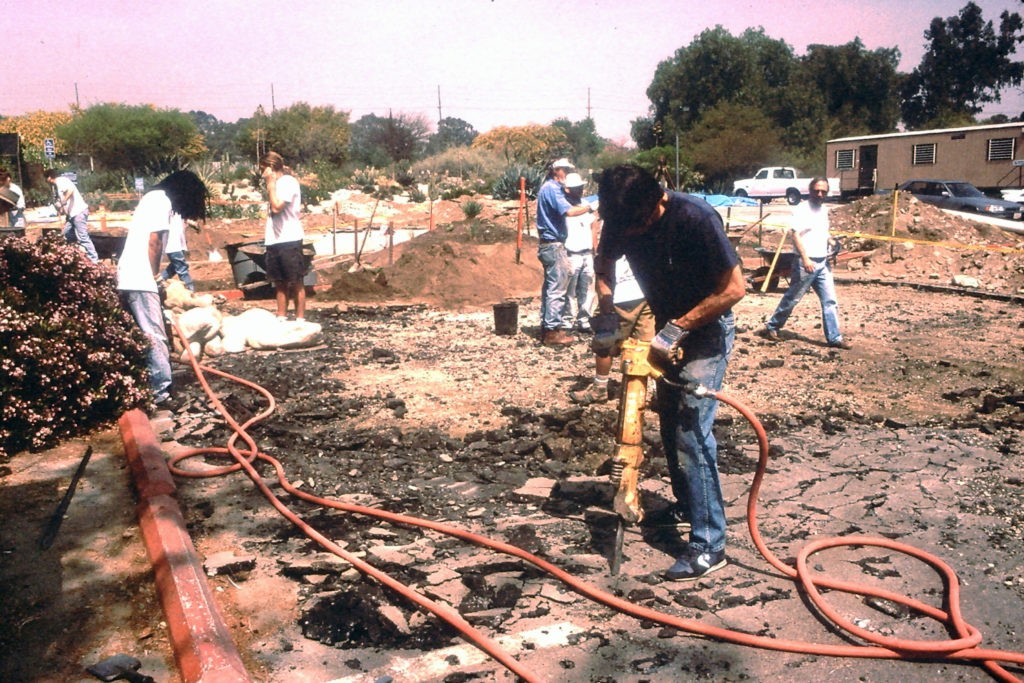 Jackhammering the parking lot behind the Grove House in September 1994.
Jackhammering the parking lot behind the Grove House in September 1994.
The origin story of the Pitzer College Student Garden in 1994 is quite similar to the revitalization that it has undergone this year. A community-wide effort transformed the space from a 12,000-square-foot asphalt parking lot into a dryland garden with fruit trees, vines, and vegetables. In January 2021, a generous donation catalyzed a committed group of stakeholders, including students, faculty, and staff, to re-animate the garden from a state of neglect. Throughout the following year, I worked with my peers on the revitalization planning committee to co-create a plan woven from fellow community members’ hopes for the space. We collected feedback from surveys, which indicated one of the top priorities was to transform the garden into a more active growing space with greater opportunities for community engagement.
By the time March 2021 rolled around, the student garden plan had begun to take shape into something far beyond the scope of the original project. At this point, five students were now involved in the garden revitalization process, and together we wrote about our dreams for the garden in a collaborative piece published in Pitzer’s student newspaper, The Outback News. As the committee worked to develop a plan for the space, we reflected heavily on how to weave together the feedback from the survey towards transforming the garden into an ecological and educational haven. In the next few months, our ideas began to blossom. Underground irrigation was installed, 26 chicks moved into their brand-new coop, and each of us who had applied for staff positions was hired to work in the garden. When we returned to campus, we were ready to start building the soil and get things growing.
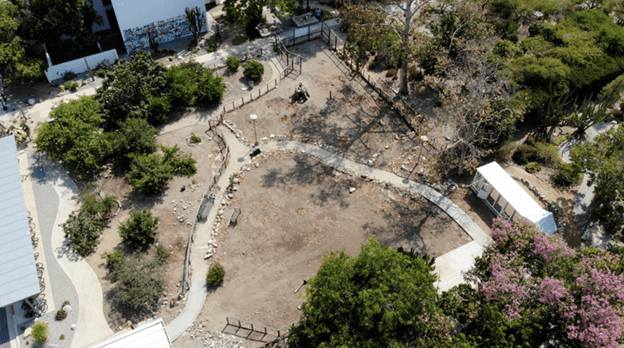 The Pitzer College Student Garden, April 2021
The Pitzer College Student Garden, April 2021
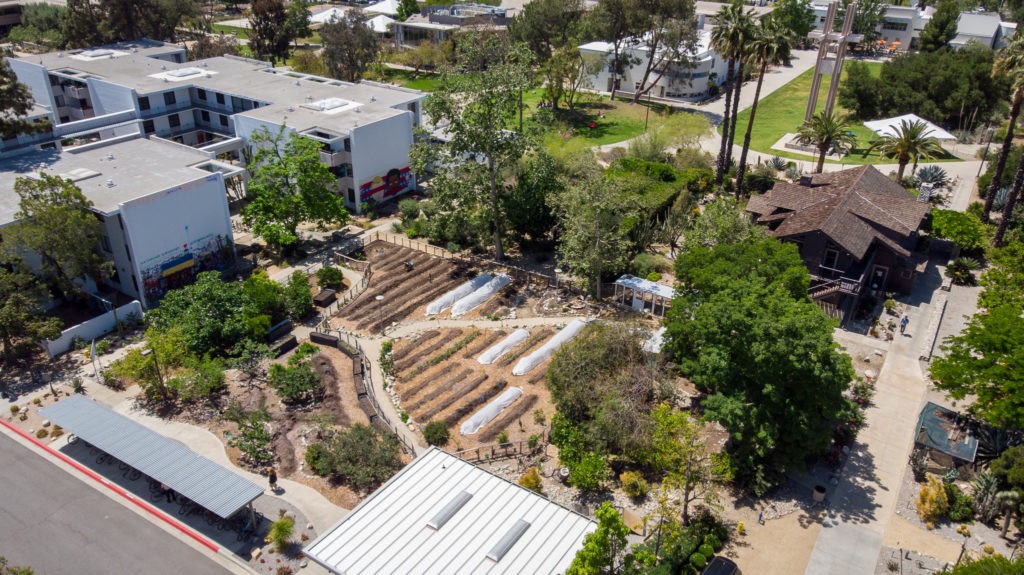 The Pitzer College Student Garden, April 2022
The Pitzer College Student Garden, April 2022
At Pitzer, we know that access to fresh, healthy food isn’t a simple matter of supply and demand but of justice. When the pandemic hit the US, it revealed the fragility of food supply chains. Grocery stores across the country were a mess of shortages, and many people panicked, exacerbating the situation. With a handful of corporations controlling the food supply chain, this was a disaster waiting to happen. Witnessing this on the heels of my experience abroad solidified my determination to learn from the small-scale food producers on the frontlines of the crisis. In the two years since, I’ve continued taking classes while working at farms and community gardens. Generations of redlining and the rise of industrialized production have resulted in food apartheid for many people across the US, and the reality is that low-income farmers and communities of color whose labor produces, packages, and distributes fresh produce in the US are those who most frequently lack access to it. The Black Panthers confronted food apartheid in Oakland with community gardening and the Free Breakfast program. Guerilla gardeners like Liz Christy and Ron Finley have transformed urban lots in New York City and Los Angeles into green spaces abundant with fresh food. Local community organizations like Huerta del Valle, Uncommon Good, and Buena Vista Community Garden are actively building regional mutual aid networks that confront systemic inequities by making affordable, healthy, and culturally relevant food accessible in Claremont, Covina, Ontario, and Pomona. These are the agroecological “alternatives” that shine a light on what is possible when we dare to imagine what an equitable and truly regenerative food system can look like.
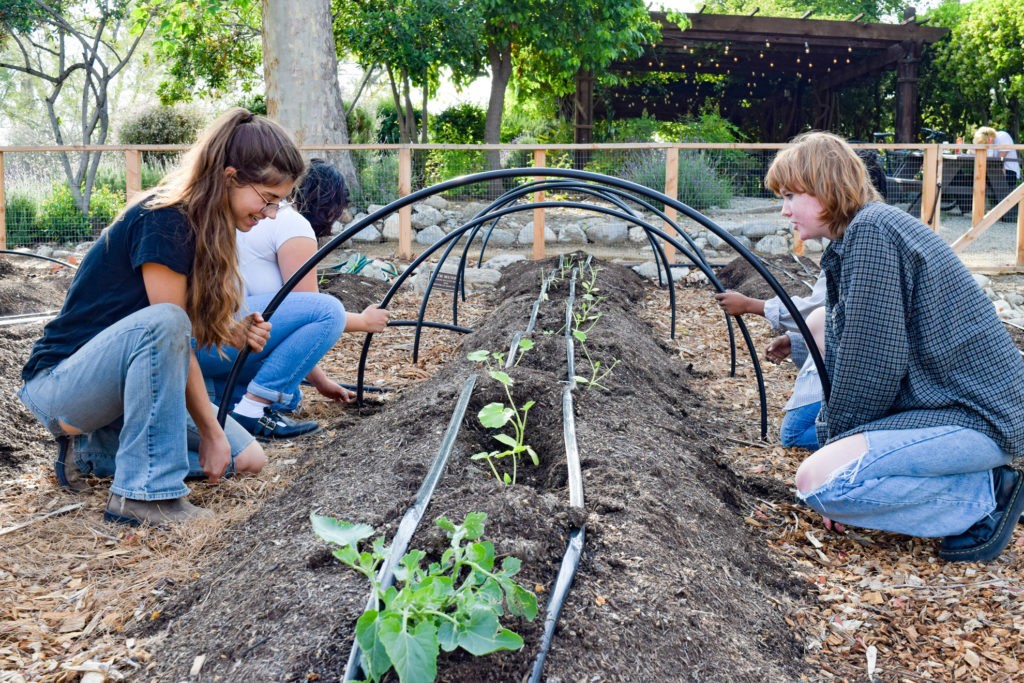 The author, Em Kuhn ’22, left foreground. See more photos of the student garden in the photo gallery below.
The author, Em Kuhn ’22, left foreground. See more photos of the student garden in the photo gallery below.
The Pitzer College Student Garden has become a small but meaningful piece of this vision. My education at Pitzer could not have culminated in a more perfect final project. As I look out at the space, filled with projects underway, the hope I feel is immeasurable. I imagine this space becoming increasingly embedded in a relational network with other urban farms in our vicinity, giving birth to an agroecology studies program grounded in experiential learning. Community gardens draw people in with the life and infinite possibility that they hold, and I truly believe that they are at the heart of transformation for a brighter future. They teach us about our relationship with the planet and each other by assuring us that what we nurture will grow. The seeds we plant today will be nourished by these bright-eyed Pitzer students tomorrow, and though these trees will not bear fruit until long after I’ve graduated, they will serve as a living labor of love that will connect generations of Pitzer students to come.
About the Author
Em Kuhn ’22 is an environmental sociology and Spanish major who helped create the Pitzer Student Garden Revitalization Project as a former Student Senate sustainability representative. Kuhn studied abroad in Ecuador and received a research Fulbright to return to the South American country to research the cultural resilience of urban and rural Kichwa farming communities. At Pitzer, Kuhn co-founded The Outback News, a student-run Pitzer newspaper, and served as a Writing Center fellow.
About the Photographer
Kasidit “Gunn” Phikrohkit ’22 is a critical global studies major who has worked with Pitzer’s Communications team as a communications assistant and student photographer since his first year at the College. An international student originally from Chiang Mai, Thailand, Phikrohkit graduated from United World College ISAK Japan before enrolling at Pitzer. Phikrohkit’s post-graduate plans include earning his graduate degree in global studies at the University of California, Irvine.
Photo Gallery
